#Transcend Censorship
Text
Navigating the insurance and legal systems with a brain injury: Tips for self-represented plaintiffs
#Me: Please summarize this entire thread and start it out with a fun ROSES ARE RED, VIOLETS ARE BLUE intro poem
#ChatGPT: Sure, here’s a summary of the thread in the form of a fun intro poem:
Roses are red, violets are blue,
Let me summarize this thread for you!
A plaintiff with a brain injury,
Hired a lawyer, but oh so miserably.
The attorney cheated and lied,
Leaving the plaintiff…

View On WordPress
#Brain Injury Self-Representation Litigation Intimidation Legal Assistance Justice System Disability Rights Insurance Claims Settlement Negot#IF YOU KNOW SOMETHING - POST SOMETHING#State Farm Broke Your House too?#tinyurl.com/WinWithoutLawyers#Transcend Censorship#Water Damage#WE ARE THE MEDIA NOW#When GreedGoverns#WIN WITHOUT LAWYERS
0 notes
Text
[4.0]: A Theory On Rhinedottir, Alchemy, and the Meaning of Sin
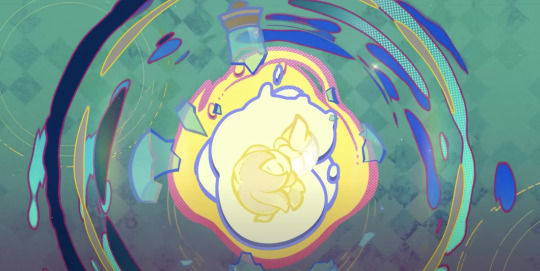
“One thought may end all calamity, and there will always be thoughts that may transcend time.” -The Meaning of Aeons
“Separate the dust in the flames with joy, and extract the exquisite from the crude. For all in the universe comes from a single source, and all things may be derived from a single thought.” -Cinnabar Spindle
I’ve been wanting to do some Rhinedottir speculations for a while. With the new Ancient Colors world quest in Fontaine, I think now is a good time to propose a theory about this mysterious member of the Hexenzirkel, her approach to alchemy, and the reason she is a “sinner,” especially within the context of one of the Archon Quest’s central questions: what does it mean to be “born with sin”?
SPOILERS: Up to Act II of the Fontaine AQ (just Primordial Sea stuff), and Ancient Colors.
Although Rhinedottir is never mentioned by name in Ancient Colors, all of the signs of her are there: Mamere’s identity as an artist, Elynas’ otherworldliness and similarities to Durin, and the differences between the Melusine’s perception of the world and our perception of it (or their aesthetics, which we will touch on later). Ancient Colors is trying to remind us of Dragonspine and, if you were playing during this time, Shadows Amidst Snowstorms, and I believe it is doing so because it is key to the secret of the Primordial Sea and the prophecy of Fontaine.
We’ve heard Rhinedottir’s perspective only twice so far, and that was in the Windblume festival from this last year and in Cinnabar Spindle’s lore. Though we still don’t know much about her, she does identify herself as a “mother” of many children, and that she is raising the only son she has left. This, of course, is Albedo.
We also know that she is considered a "sinner" at the center of the Cataclysm who unleashed "an army of shadowy monsters" onto Teyvat, but we have very little grasp of what exactly is meant by "sinner," and what if any consequences this label has had on her since then. Although every Hexenzirkel witch will undoubtedly be very important to uncovering the truth of Teyvat, Rhinedottir presents a particularly interesting case as the only one whose activities may have caused cataclysmic destruction, as opposed to Alice's general mischief and strange sense of humor.
It’s almost nothing to go off of, but I hope to demonstrate in this speculative theory that it’s more than enough to arrive at some answers.
Psychoanalysis 101, Round 2
To better explain what Durin, Elynas, and Rhinedottir’s other children are, we need to use an analogy rooted in Freud’s psychoanalytic theory of dream interpretation. This is a super TL;DR version of it and way oversimplified, but if you’re interested I wrote a more detailed theory about the significance of dreams in Genshin that has a full explanation of it there. (Also, it should be said that these were just Freud’s theories, please do not take any of the following as an accurate description of the human psyche and how it works. We are just having some fun for the sake of media analysis.)
Freud thought that dreams are the mind’s means of expressing unfulfilled wishes, and that the psychological purpose of dreaming is to “fulfill” those wishes. In A General Introduction to Psychoanalysis, he gives an example of this through a little girl’s dream where she was sailing on a lake: this dream was born out of an unfulfilled wish in her waking life, where she had to stop sailing on the lake despite wishing to continue. Hence, “I wish to sail on the lake” becomes “I am sailing on the lake” through the dream.
Further, Freud thought these unfulfilled wishes are “forgotten” in our unconscious mind when we are awake, censored by the ego to protect our conscious mind, but that at night this censorship is weakened. This is what allows a dream to occur while we sleep.
These unfulfilled wishes are often more complicated than a childish wish to keep sailing on a lake. Think about it this way: a wish is, at its core, a thought in our head, or a desire. What do we do with the thoughts we don’t like, the ones that are unbecoming of us or are unacceptable to fulfill?
We deny them.
Specifically, we repress them into the unconscious, where they are forgotten. Thing is, even if we temporarily forget these thoughts, they won’t just disappear from existence - they fester in the unconscious, waiting to be expressed. The dream, therefore, is the unfulfilled wish/repressed thought’s attempt to cross the boundary from the unconscious mind into the conscious mind - to be acknowledged, or indeed remembered.
“Unfulfilled Wishes”
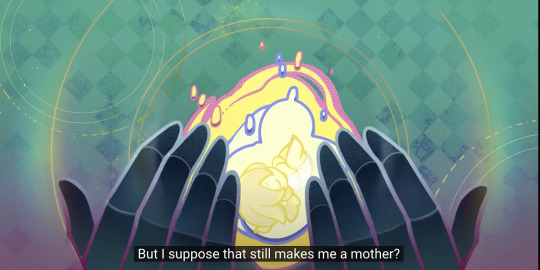
Making sense so far? If so, try to think of Teyvat like this: everything that is visible, everything above ground that the light touches and that can be perceived is like the ego and conscious mind. All of these things are what you’re aware of, things that you “know” and can make sense of, things that you understand, things that fit into rules and laws and order.
Now, think of everything in Genshin that is “unseen” and “unknown”: the Abyss, the spaces underground, forbidden knowledge, things that are “not from this world,” from beyond the firmament…these are like things from the unconscious mind, the repressed thoughts that we deny in ourselves because they may reveal a truth we are unwilling to face. These things are comparatively chaotic in nature, things we’d rather avoid, or things that we wish to forget.
We know that Elynas’ and Durin’s bodies are composed of matter that’s foreign to Teyvat, and that this is a major reason why they are incompatible with Teyvat and cause its destruction. This would make them more similar to a repressed thought, something that we don’t understand or know, and attempting to understand it destabilizes our sense of self, our “truth.” It follows that their home, the Abyss, is most similar to our unconscious mind, and Teyvat is most similar to our conscious mind.

Elynas: Before I was born, I floated in the cosmic darkness. It was cold there, and lonely. I was so sad, then, and I would often cry.
So, as their mother, who or what is Rhinedottir in this analogy? Well, we can be a lot more specific than calling her a “sinner.” In fact, she’s a dreamer, and alchemy is the medium through which she “dreams”:
This was a story from long ago...
Unborn life, unfulfilled wishes,
Tragic dreams at the edge of the universal darkness that could never come true,
Indwell my body, and descend unto this world.
Then, my lovely children,
Like rainwater flowing into creeks, and plants growing towards the sun,
Go unto a lovely place, and display your own beauty there with pride.
This is a memory, a memory that a child named Durin had of his mother…
"Thank you, Mother, thank you."
"You gave me wings to soar and a mighty form."
"Mother, I wish to go to a land of lovely songs,"
"I will tell them about you, Mother, and about everyone else."
"I shall tell them that the place where I was born is beautiful."
-Festering Desire
Rhinedottir’s children, then, are like thoughts or ideas that she is bringing to life, or “making conscious,” by moving them from the Abyss to Teyvat. It may even be the reason why the sword from The Chalk Prince and the Dragon is called Festering Desire in the first place - it’s a reference to the idea of repressed thoughts, wishes, and desires festering in the unconscious.
Should the analogy hold true, it provides some insight into what her intentions may have been in creating her Abyssal dragons. But before that, we need to take a little detour into Enkanomiya and brush up on some lore.
Denouement of Sin
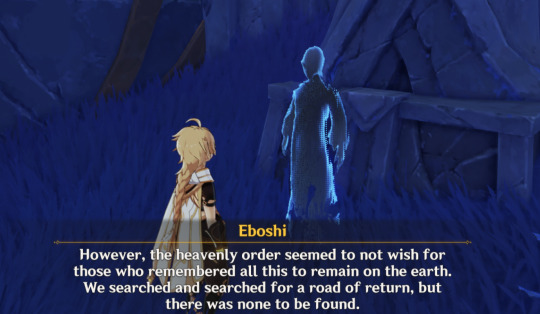
Eboshi: However, the heavenly order seemed to not wish for those who remembered all this to remain on the earth. We searched and searched for a road of return, but there was none to be found.
Remember these hologram-looking dudes? They are the Shades of Tokoyo, also known as Sinshades. They are described as afterimages of the former citizens of Byakuyakoku preserved by Istaroth’s favor, specifically those citizens’ most powerful emotions, and they are only visible during Evernight:
Eboshi: Due to the phenomenon known as Sinshades, the “past,” “history,” and “truth” of Enkanomiya would endure even if left to their own devices.
Eboshi: As such, great effort was expended, not that we might remember, but that we might “forget.” Lady Sangonomiya was of this view.
Like a dream, Sinshades only appear at night, and they are a kind of embodiment of history or “truth” that Watatsumi Island has chosen to forget, representing the thoughts and emotions of those who once lived in Enkanomiya. Using Freud’s theory of dream interpretation as a framework, Enkanomiya then functions as Watatsumi Island’s unconscious mind.
Put another way, if all Sinshades are the result of strong emotions preserved in time through Istaroth’s favor, then those emotions are like thoughts, and that would make the Sinshade a “physical” form or expression of those thoughts. So, when we call the afterimages the “Sins of Tokoyo,” we are in effect calling them the “Dreams of Tokoyo,” because they are the thoughts and emotions of Enkanomiya given form, and that’s what dreams do: they convey thoughts and feelings through a series of images.
Through the Sinshades, we see an implicit association with the concepts of dreaming and sinning in Genshin’s worldbuilding, and through them we understand that they are not so different from one another.
A Brief Note on Aesthetics
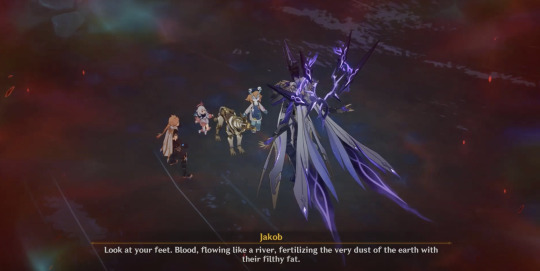
Jakob: Look at your feet. Blood, flowing like a river, fertilizing the very dust of the earth with their filthy fat.
It may have struck you how various Melusine perceive reality in a way that greatly differs from the things we see, as if at times their perception was “flipped,” if not somewhat strange. By the end of Ancient Colors, it’s clear that this is due to the Melusine being born of Elynas, who is not from this world. A similar phenomenon can be seen in both Durin and Elynas, the former imagining itself dancing with the people of Mondstadt before it “woke up” from this dream to Dvalin’s fangs in its neck, and the latter realizing that the things that it finds fun are destructive and harmful to the people of this world.
This is a part of the commentary present in several world quests and commissions in Fontaine that deal with “aesthetics,” or one’s own sense of beauty. Aesthetics are principles that differ on both large and small social scales, varying between groups of people and between individuals (see Salsa’s and Ubu’s aesthetic disagreement), and they can change throughout time as values change. In other words, they are informed by perspectives.
For example, think of what we know so far about the Primordial Sea. Neuvillette wonders how the Primordial Sea could be capable of giving life and then “suddenly reversing itself” so that it instead “devours life,” but this is just his judgment of what the sea does, and ultimately his perspective. Many others view the properties of the Primordial Sea differently from him: to them, the prophecy is comforting because it signals a “return,” or a “homecoming.” To take it a step further, Neuvillette may be making an assumption by stating that the sea has reversed itself. Perhaps this is just how the sea is, perhaps this is its “truth.”

Verenata: The "truth" will not be limited or constrained by the eyes and perspectives of the viewer, and won't be distorted by what is in their heart. It objectively exists, and it just is...like the white sand, like the bones of seastars, like the waves that crash and pound...those are "truth."
Now, imagine that you are staring at a 3D object from a 90 degree angle. If I ask you to describe the object from where you're standing, you'll be able to accurately tell me about what roughly half of the object looks like, but you won't be able to accurately describe the other half of it without help from someone standing on the other side of the object.
But how can you be sure there even is another side of the object, or that it's any different from the one you see now? From your perspective, what is already visible to you may seem sufficient to describe the object in its entirety. In other words, your perspective becomes your "truth."
It is only through considering additional perspectives that we broaden our own understanding of reality and expand on our "truth." However, broadening our perspective is usually not a comfortable experience, as is typical when we engage with ideas that differ from our own. Part of expanding our "truth" requires us to shatter our current understanding, pick up the pieces, and reassemble them into a shape that makes space for these other ideas and their "truth."
For example, when we confront Jakob at Elynas' heart, he describes the rushing currents beneath our feet as Elynas' blood. To the player, who has been swimming around in that for a couple of hours by that point, this idea is macabre and horrifying. However, when we consider Jakob’s perspective, his “truth,” it also expands our understanding of Elynas as a being that is somewhere between dead and alive, sleeping if you will, and that he is more than capable of waking up from his slumber with the appropriate stimulus. Another example is Canotila, who saw the wasteland in Rene's Book of Esoteric Revelations as a peaceful forest. When we consider Canotila's "truth," her aesthetic sense doesn't change the way we see the wasteland, but it does show us something equally important: the way that we experience the wasteland is not the only way it can be experienced.
If we return to the other ever-present metaphor of alchemy as a form of painting, we can see that Rhinedottir’s aesthetic sense greatly differs from what is acceptable and compatible with Teyvat. But, just like Mamere, she paints regardless of whether her paintings are understood by a greater audience. In time, Teyvat's "aesthetics" may change again, and perhaps her "art" will be received differently when that time comes.
Concluding Thoughts
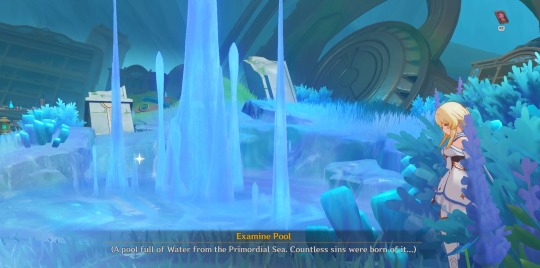
(A pool full of Water from the Primordial Sea. Countless sins were born of it…)
So, that is why I think Rhinedottir was deemed a sinner. She sinned by “dreaming” up these chaotic life forms that were not from this world, bringing them into being through the Art of Khemia, and telling those chaotic life forms that they were beautiful, too, that the ordered and lawful world of Teyvat just needed to realize how beautiful they were. Maybe Rhinedottir was dreaming of a new world, one where her children’s wishes could be fulfilled, where they could exist with everyone, and maybe creating that world required the destruction of this one. You could also think of her as someone who has introduced “external variables” into Teyvat, which, hmmm..:
“...No matter how many times I derive it, the result remains the same, though this result is not expected... Unlike the world depicted in these ancient texts, there will be no more new civilizations born... Unless we consider introducing "variables" from outside the system... If it was that sort of power, there might be a chance…” -Enigmatic Page I, Book of Esoteric Revelations
In this way, her “children” (thoughts) were all “born with sin,” or are born from sin (dreams). If Rhinedottir is a dreamer, then alchemy is the way that she dreams: it allows her to give forms to these thoughts. And if you buy that, then there are some serious implications to consider from this whole notion of Fontainians being “born with sin,” and just what exactly the Primordial Sea might be. Definitely something to think about while we wait for 4.1.
One last point that is more of an aside than anything else: Rhinedottir’s only remaining child is Albedo, but through this lens we see that he is not just the culmination of the Primordial Human Project, the creation of a human through the power of alchemy, but also the only known example of Rhinedottir’s “ideas” that coexists with Teyvat as it is now. As for her known extant grandchildren, they have integrated with Fontainian society and don’t seem to cause them any trouble. I wonder if she knew something like that could happen?
But…that’s just my take on it so far. What do you think?
(also, fun fact: there is a parallel storyline to this one unfolding in Honkai Star Rail right now as it relates to being deemed a “sinner” for creating life, and another parallel storyline in Honkai Impact 3rd about creation and rebirth and “returning home to the sea” and I just love when Hoyoverse connects their games like that)
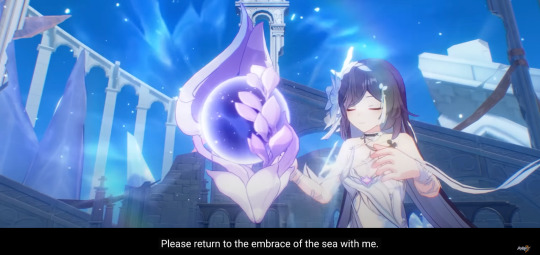
EDIT (9/8/2023): Touched this up a bit and made some grammatical corrections. Thesis is the same, some added support and re-phrasing was done to better convey it.
Sources
A General Introduction to Psychoanalysis by Sigmund Freud
#genshin impact#genshin lore#genshin impact lore#genshin theory#genshin meta#genshin impact meta#fontaine lore#rhinedottir#theory#elynas#durin#melusine#long post
242 notes
·
View notes
Note
Theory on World Dynamic & Blot Pt. 1 (No Beta, apologies in advance for any and all confusion you may have when reading this. Please delete this is you don't feel comfortable with this):
One of the things I didn't get at first was why the Seven were considered role-models in TWST---I couldn't pinpoint how society would openly idolize people for actions that are openly admitted as wrong in a unanimous sense yet not have someone openly question/challenge this. The Seven are historical figures. Some of the dialogue we do get hints at imperfection that are more close to D!Villains the audience is more familiar with. Assuming Earth is meant to be referring to our Earth (in which it is taken in it's entirety without altercations), I think TWST is meant to have similar core parts that reflect our real-world. History-context-wise, it would make more sense that royal/governing figures(Queen of Hearts, Scar, & Jafar) would be recorded---even considered an example to TWST's present day royalty/governing system on do's and don'ts---and respected as seen by the description on the statues (being able to govern over (what I will assume is) a massive population and having the nation surviving---even thriving---are (objectively) ideal feats to be remembered by and put as positive example in the grand scheme of things). If this is true, then it would also make sense for the Seven to coexist with their respective protagonist(s), making RSA possible but also making the dynamic not as black-and-white as simplification will allow. . .Yana didn't need to write an explanation w/worldbuilding cuz she played it smart and just used what she already had---existing reference called real life.
(Note: I know that this ask opens with “part 1”, but I never received any part 2s or other follow-ups after that DX)
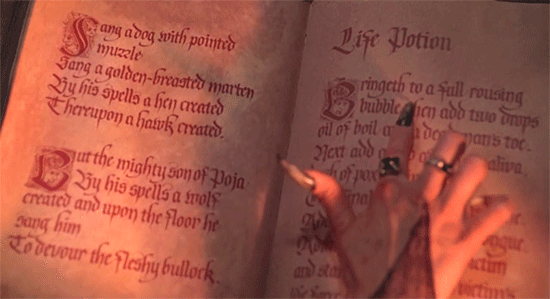
I think I get what you’re trying to communicate? (Correct me if I’m wrong!) So I believe this Anon is saying that 1) both the Disney villains and heroes exist in Twisted Wonderland as historical figures, 2) the alternate tellings of their histories can coexist, and 3) like in real life, history can be twisted depending on the narrative/teller and, in hindsight, actions that are considered dubious can be viewed by future generations as morally correct or righteous. (If that’s the case, I expressed similar thoughts in this post.)
There instances in which the original stories they come from diverge or coexist with other versions which are also treated as true. For example, Kalim tells a tale about a princess (Jasmine) who happily married a thief (Aladdin), transcending the social norms of their time. There is also another tale that the Sorcerer of the Sands (Jafar) revealed that someone (Aladdin) had deceived a princess (Jasmine) about their social status, and that he saved the kingdom by revealing the lie. Somehow, the original story became multiple stories, all of which stand on their own.
We must recall that there are often positive spins put on the tales we know of to be the truth; suddenly Jafar is no longer plotting to overthrow the Sultan, but is a loyal advisor who dutifully served his country, Ursula’s deals are justified because the fault lied with her clients for not paying up, etc. This is also true of real life, where, depending on the person you ask or the history textbook you reference, certain events and details may be glossed over or even completely rewritten. This may be due to censorship or a deliberate attempt to control the narrative and what information is taught to and carried over to students (and into the future). Lilia even makes a passing comment about this in episode 7, saying that history can be “changed” over time.
This is likely how and why the Great Seven are worshipped as they are; history has been “twisted” from the (presumably what Yuu views in their dreams), which just goes to show that good is closer to evil (and vice versa) than expected, thus blurring the lines between the two and creating a grey area. This is very much in line with TWST’s philosophy—that there is more to something than meets the eye, and that being truly “evil” or truly “good” doesn’t exist.
#Lilia Vanrouge#twst#twisted wonderland#disney twisted wonderland#twisted wonderland theory#twisted wonderland theories#twst theories#notes from the writing raven#twst theory
94 notes
·
View notes
Note
hi! i've seen you post about it a lot, could you explain nerdy girl overdose? something about anime girl doing drugs is appealing and i feel like you can explain it better than a wikipedia article
Uhm hi!!! needy girl overdose is a management game. you play as the faceless boyfriend of ame, who wants to be a streamer. the gameplay is basically deciding what activities ame should do. she has a new idea for a stream, she could really grow her view count with it. or how about a date night, shes really stressed and could use some time with you. how about the hospital? shes been falling into a dark place lately and might hurt herself. you have to balance these things and see where it takes you. theres so many endings possible that can be 30 minutes or like 2+hrs(?) each, lots of replayability
One big appeal is the overall loveletter to the internet that the game is. the localization is spot on and full of references and jokes and subcultures that is very hard to capture if you havent been around through them (very early one youll see is a RANDY YOUR STICKS reference). it goes into the parasocial relationship the develops in online spaces, having an identity or persona that seen by others. wanting to be seen and loved, how your persona can grow, and these interactions can turn toxic if left unmanaged
Another part of the game is that its very deep into the menhera subculture. its got a lot of emphasis on mental health and dealing with mental issues. ame gets depressed, or goes manic, or abuses her medication, or SH's. theres some. really really good letters she has on some of these things.
The game can get dark, not because it tries to, but just because these things are so intertwined and connected that you kind of have to have it, if you want to be as genuine as you can be. theres not really a central Point to the game, its mostly just. a loveletter to the internet, for all its goods and bads. from the sense of community and belonging that transcends physical bounds, to the destruction and toxity and abuse it can enable for the self and others, the game kind of embraces it all
Switch version has some censorship (drugs are macarons now lol, idk what other changes there are) but its there if you want accessibility to play it, its on steam too, if you're interested, id say pls check it out if you're up for it :3
this should go without saying but this game is not meant to enable self harm or abuse. as i understand, menhera is not so much about getting worse, but using imagery of dark themes with a cuter look as a way of helping to get out of bad habits. like using poison as an antidote, and thats what this game does for me a lot. the darker art and themes helps me vent in a way and holds me off from doing things. take care of yourself! be kind to yourself! dont be mean to your body. its doing the best it can.
28 notes
·
View notes
Note
hi! i just found this if and I'm just wondering what does muhyeop and murim mean?
sure! this is about to get long (lol) but i'll try to do it as clearly as i can. as succinctly as possible, muhyeop is a historical korean fantasy genre featuring martial artists, and murim refers to the martial arts society/world within the story. some people like to use the terms interchangeably.
muhyeop is considered an offshoot of a genre that was popularized in china (that's why the story is set in china!) and is heavily influenced by authors like wolong sheng and gu long. you might've heard of terms like wuxia (lit, martial heroes) which focuses on the adventures of martial artists and xianxia (immortal heroes) a more fantastical take on the genre that includes principles from philosophies, customs, and religions like taoism, buddhism, and traditional practices. muhyeop is in the same family as those genres.
it's very, very popular and there's an interesting history behind it. some scholars argue the genre served as a mouthpiece when direct political protest was banned (which led to censorship of published books in korean and taiwan). they have a little historical basis to them, but it's a broad term. like how "fantasy" as a genre in the western world can mean anything from modern-day star power warriors to Ye Olde Knights Slaying Dragons.
a lot of common tropes include examples of immortality achieved through personal cultivation and/or martial might, good vs evil, chivalry, sword fighting (duh), and transcendence of mortality. there are four main generations of the muhyeop genre (a first-gen muhyeop author founded one of the largest webnovel publishing sites in korea!) and each gen expanded on set tropes and established new ideas/principles.
murim or wulin refers to the martial arts society that appears in muhyeop stories and is based on the actual martial arts society that was believed to have existed during the dynasties. the clans and families that are featured in the story also have historical significance, but ofc since people weren't actually using internal fantasy powers to achieve feats like immortality and super-strength, they just co-exist with their irl counterparts.
if this is your introduction to it i'm super happy to have explained it a little, and i hope it sparked your interest! there are thousands of incredible series and media out there, and i hope you check some of them out!
#anon#what do i tag this as#world building#let's go with world building#if you want to talk about it more#i can go allllllll day#(ignore the spelling mistakes i typed this on my phone)
18 notes
·
View notes
Text
The bowdlerization of Roald Dahl

Here’s the full story. Lap it up. Bathe in it. This is your victory. You have earned it. Don’t be shy in showing off your achievements.
I warned against this, multiple times. The kindest responses I received were indifference or accusations of paranoia. The worst response was being wished away to live among the other Wrongthought Damned. For some--a group who now wield near-absolute authority over all aspects of culture--suggesting that, perhaps, it’s not a great idea to embrace proactive censorship in the name of social justice... well, I would have been better off had I said that slavery was fake or Hitler had some good ideas.
This isn’t going to stop. They will come for anything and everything, including the works you consider sacred. Your protestations, if you’re naive or foolish enough to make them, will be futile.
I’m tempted to dig into this further, but I fear doing so would only dignify the phenomenon. At heart, this is nothing more than a rank hatred of humanity and its cultures, a belief that meaning can exist without context, that the values of Right Now are not only impeccable but that they transcend all time and space. Effectively, the purveyors of this movement cannot conceive of a world beyond their own heads, which means they find no value--none at all--in any work of art.
And, because our institutions are uniformly run by self-serving, ignorant cowards, there will be no stopping them.
43 notes
·
View notes
Text
Shostakovich's violin concertos are an absolute marvel of musical brilliance, showcasing his unparalleled talent and revolutionary ideas. From the moment the first note is played, it is clear that these concertos are a testament to his unique style and innovative approach to composition.
The style of Shostakovich's violin concertos is characterized by a perfect blend of traditional classical elements and his own avant-garde tendencies. He effortlessly weaves together melodic lines and intricate harmonies, creating a tapestry of sound that is both captivating and thought-provoking. His use of dissonance and unconventional harmonic progressions adds a layer of complexity to the music, challenging the listener to delve deeper into the emotions and narratives conveyed by the violin.
But it is not just the style of these concertos that sets them apart; it is the harmony that truly captivates the audience. Shostakovich's harmonic language is daring and groundbreaking, pushing the boundaries of what was considered acceptable in his time. He fearlessly experiments with dissonant chords, creating moments of tension and release that are as thrilling as they are beautiful. The harmonic progression in his concertos is unpredictable and unexpected, keeping the listener on the edge of their seat, never quite knowing where the music will take them next.
What truly sets Shostakovich's violin concertos apart, however, are the revolutionary musical ideas that he explores. In a time of political turmoil and censorship, Shostakovich used his music as a means of expressing his discontent and challenging the status quo. He infused his compositions with themes of struggle, oppression, and resilience, creating a powerful narrative that resonates with listeners to this day. His ability to convey deep emotions through his music is unparalleled, as he crafts melodies that evoke a wide range of feelings, from melancholy and despair to hope and triumph.
Shostakovich's violin concertos are a testament to his genius and unwavering commitment to pushing the boundaries of what is possible in music. They showcase his unique style, daring harmony, and revolutionary musical ideas, leaving a lasting impact on all those who have the privilege of listening to them. It is through his music that Shostakovich's legacy lives on, inspiring generations of musicians and reminding us of the power of art to transcend political and social barriers.
6 notes
·
View notes
Text
TOOL
Poster designed by: @demoncore164

Tool is an American rock band from Los Angeles. Formed in 1990, the group consists of vocalist Maynard James Keenan, guitarist Adam Jones, drummer Danny Carey and bassist Justin Chancellor, the latter of whom replaced founding member Paul D'Amour in 1995. Tool has won four Grammy Awards, performed worldwide tours, and produced albums topping the charts in several countries.
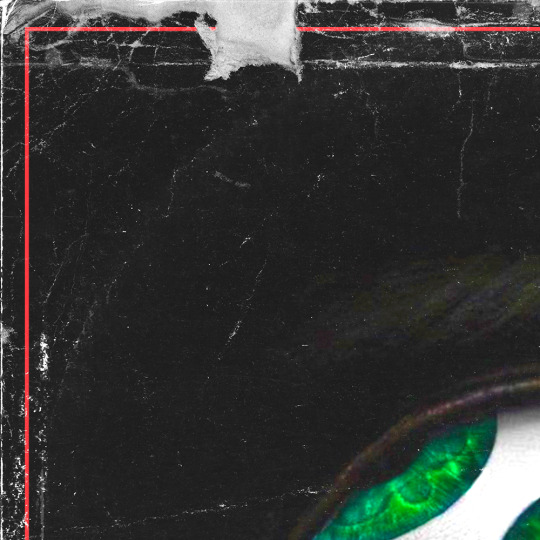

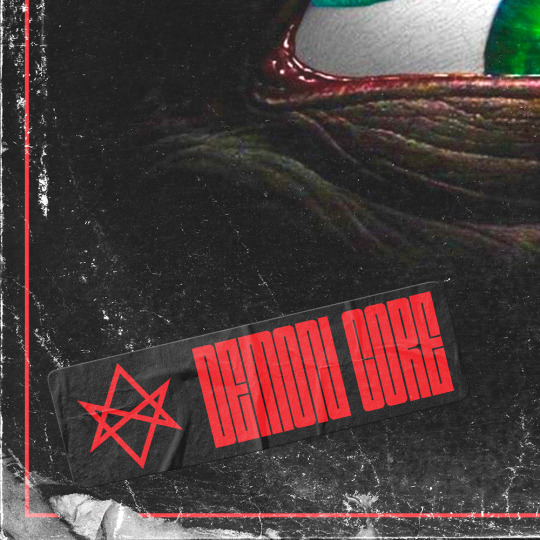

Due to Tool's incorporation of visual arts and very long and complex releases, the band is generally described as a style-transcending act and part of progressive rock, psychedelic rock, and art rock. The relationship between the band and today's music industry is ambivalent, at times marked by censorship, and the band's insistence on privacy.

Discography
Undertow (1993)
Ænima (1996)
Lateralus (2001)
10,000 Days (2006)
Fear Inoculum (2019)
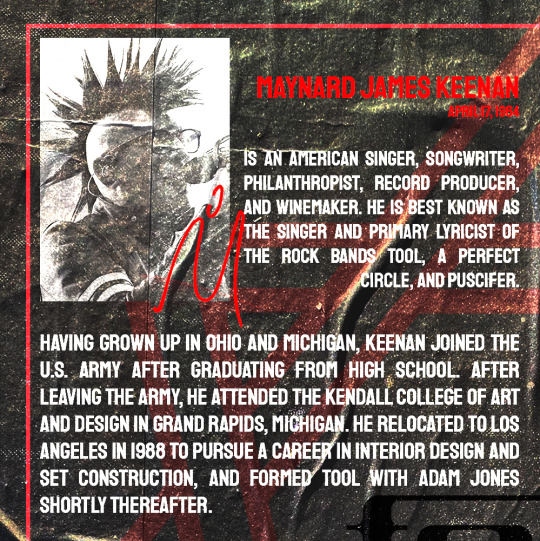
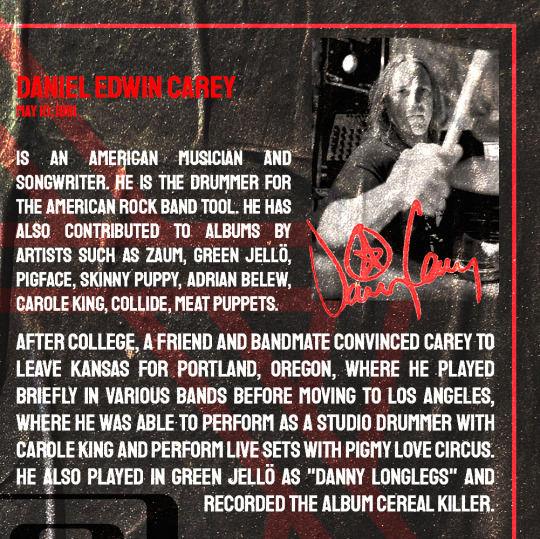


#art#artwork#digital artist#dark aesthetic#darkness#music#tool#adam jones#maynard james keenan#justin chancellor#danny carey#undertow#aenima#10.000 days#lateralus#opiate#fear inoculum#design#artists on tumblr
4 notes
·
View notes
Text

@stripedroseandsketchpads
I DO have thoughts on the manga. I think it’s important to remember that the manga is like essentially just a pitch for the Utena show. I feel a little bad for Chiho Saito because she was faced with such pressure for censorship and Ikuhara could do whatever he wanted because he had already directed the third season of Sailor Moon.
The Utena manga is like a watered down RGU tbh. Possibly do to the censorship Saito faced, where as Ikuhara expresses the queer elements of the show so much better. (Saito’s Utena is different, especially because like the relationship between her and Touga is more like that in Adolescence of Utena.)
But both are very much like the love between women is what will save us.
It’s kind of hard to have a lot of thoughts about it. I read it after watching the anime which is like ... one of the best things I have ever watched period. So it sort of feels like it’s not giving you enough. It’s not hitting the same critique Ikuhara did. And yeah it feels less like a Queer romance until the very end when Utena has gone missing and Anthy assumes the role of “Prince”.
Now I do think though that it works in conjunction with the show + the Adolescence of Utena + After the Revolution (which is currently on my shelf I just haven’t had the time to read it yet.) But I think that like the stories weave together with Anthy as the protagonist.
Considering Anthy is basically a reality warping all powerful goddess (made explicitly clear by the manga) she keeps expressing this power as a way to break free from the patriarchy. So you get these ends where Anthy becomes the prince --- > Anthy leaves the dueling system behind --- > there never was a prince at all, he was always rotten and this crumbling system is trying to hold her back and keep her and everyone else there. ----> It is time for everyone else to get free.
I think the thing about Utena that always like ... it grips me in such a way is that the real message Ikuhara sends is that it is such a clear message about the patriarchy and that fighting within the confines of it will never allow for freedom. To break free, the whole thing must be destroyed. The dueling games can’t exist without Anthy, Akio’s power is destroyed the second she leaves, there is nothing for him his power is all false and it was all dependent on Anthy’s subjugation.
And that the way we break free from this cycle of violence, is to lift each other up and love one another. And that quite literally, the love of Utena is what saves Anthy. Like this idea that the love we have for one another is the truest, most revolutionary act. That love transcends violence. And back to the queer themes of the text, the love that Anthy and Utena have for one another saves them.
Honestly I could like say a lot more, like this isn’t even going into the concept of the rose bride, as a reading of the institution of marriage. The foil of Nanami. The way Juri attempts to play by the rules of the dueling game while being a lesbian. The way Ikuhara doesn’t give you a single redeeming man, and yet at the same time those men are victims of the dueling game too, the concept of Anthy as a “witch” -- like I truly could go on and on about Utena.
And I love that we’re meant to.
But yeah as far as the manga goes, I think it’s good for lore + looking at it as a beginning to the story, the first chapter. It works tied to the show, but without the show I think sadly it’d be pretty forgettable.
#Revolutionary Girl Utena#i would like to honestly have a whole section of my dissertation just on utena#stripedroseandsketchpads
76 notes
·
View notes
Text
Best Practices to Transcend Censorship on LinkedIn and Twitter Today
Let’s Ask AI about social media and censorship…
Maybe some of us left standing can collaborate with LinkedIn learning to ensure compliance with First Amendment of the Constitution of these United State of America.
Connections in other countries might be re-inspired by Freedom of Speech in America
1. Censorship is the act of suppressing information or ideas that are considered objectionable or…

View On WordPress
#StateFarmFiles#TwitterFiles#1. Censorship 2. Shadowbanning 3. Virtual book burning 4. Freedom of expression 5. Freedom of speech 6. Human rights 7. Internet freedom 8.#BACK UP#BLOG#BUILDING EMAIL LISTS AND TELTEXT LISTS#DOWNLOAD#Transcend Censorship#USA legal world ethics crisis – NOT ONE DEFENSE COUNSEL OPPOSED FIRST AMENDMENT ATTACK!#VIDEO23#WE ARE THE MEDIA NOW
0 notes
Photo

Today marks the 10th anniversary of the passing of the legendary Ray Manzarek. Born on February 12, 1939, in Chicago, Ray's upbringing was steeped in a rich musical environment. From an early age, he showed immense talent as a pianist and organist, drawing inspiration from jazz, blues, and classical music.
Ray's path took a momentous turn when he crossed paths with Jim Morrison in 1965. Together, they formed one of the most iconic rock bands of all time, The Doors. Ray's mastery of the keyboard and his ability to create mesmerizing melodies perfectly complemented Jim's poetic lyrics and charismatic presence. The Doors' unique sound became a defining force in the psychedelic rock movement of the '60s.
Their musical success knew no bounds, with hits like "Light My Fire," "Riders on the Storm," and "Break on Through (To the Other Side)". The enigmatic blend of Ray's hypnotic organ playing and Jim's profound lyrics created an ethereal and introspective experience for listeners.
Tragedy struck in 1971 when Jim Morrison passed away, but Ray's passion for music endured. He continued to pursue a solo career and collaborated with numerous artists, embracing different genres and experimenting with his sound. His post-Doors albums like "The Golden Scarab" and "Carmina Burana" showcased his versatility and creativity as a musician.
Ray was classically trained and earned a degree in cinematography before diving headfirst into the world of rock music? His diverse background undoubtedly contributed to the Doors' distinctive style and their ability to push artistic boundaries.
"Light My Fire," is one of the Doors' most iconic songs. Released in 1967, this timeless masterpiece carries a deeper meaning beyond its catchy melody. It explores themes of liberation, desire, and the transcendence of boundaries. "Light My Fire" became a symbol of the counterculture movement, resonating with an entire generation.
The Doors' appearance on The Ed Sullivan Show in 1967 became a controversial moment in television history. The producers wanted them to change the line "girl, we couldn't get much higher" due to its drug-related connotations. However, the band stood their ground and performed the song as originally intended, marking a rebellious act against censorship.
Today, we pay tribute to Ray Manzarek, a visionary musician whose influence continues to ripple through the decades. His legacy is forever etched in the annals of rock history, and his contributions to the world of music are immeasurable. Rest in peace, Ray, and thank you for the endless inspiration you've provided.
#RememberingRayManzarek #TheDoors #MusicalLegend #LightMyFire #PsychedelicRock #Legacy #InfiniteInspiration
14 notes
·
View notes
Text
On Tuesday, the Fifth Circuit Court of Appeals broadened an existing injunction to encompass the Cybersecurity and Infrastructure Security Agency (CISA) under the Department of Homeland Security (DHS), amid allegations of unconstitutional collusion with big tech firms to silence “election-related speech.”
This move follows a court order that denounced a probable First Amendment infringement by a key agency within the Biden administration.
Missouri Attorney General Andrew Bailey, spearheading the legal challenge against the administration, dubbed CISA the “nerve center” of a purported “vast censorship enterprise” orchestrated by the White House.
“CISA was created to protect Americans from foreign attack, and now it has begun targeting its own citizens,” Bailey said, according to Fox News.
He further alleged the involvement of CISA with the Federal Bureau of Investigation (FBI) in muffling the narrative around the Hunter Biden laptop incident.
The litigation, initiated by Missouri and Louisiana’s attorneys general, pointed fingers at high-tier government entities for allegedly conspiring with major social media outlets “under the guise of combating misinformation,” leading to the suppression of dialogues on several topics including the origins of COVID-19, the effectiveness of face masks, and Hunter Biden’s laptop.
The judicial panel underscored CISA’s pivotal role as the “primary facilitator” of the FBI’s liaisons with social media giants, coercing them to amend their moderation policies specifically towards “hack-and-leak” content.
The court document narrated CISA’s operation as a conduit, “merely relaying flagged social-media posts from state and local election officials to the platforms.”
However, the reality of CISA’s actions transcended this benign description, moving towards what the court order labeled as “[s]omething more.”
It was elucidated that CISA exploited its regular engagements with these platforms to advocate for stricter censorship measures on election-centric discourse.
4 notes
·
View notes
Text
Tumblr's Paradox: Freedom at the Crossroads of Openness and Responsibility
Social media is like a miniature society within the screen, with each platform offering different experiences. Among them, Tumblr stands out as a vibrant digital community where users immerse themselves in a diverse array of content and interactions.
The Allure:
What sets Tumblr apart from its counterparts is its unique approach to creating and consuming content. The platform's "mini blog" structure provides users with a framework to express themselves succinctly yet profoundly (Reeve 2016). Whether through short texts, captivating images, mesmerizing videos, or soul-stirring music, Tumblr offers a pathway for individuals to articulate their thoughts, emotions, and artistic endeavors in a visually compelling manner.

Moreover, Tumblr's interface is designed with a focus on user interaction, fostering engagement and connectivity among its diverse user base. The platform's reblogging feature allows users to share content seamlessly, expanding its reach and igniting conversations across various communities and interest groups. Through likes, comments, and blog reblogs, users establish connections, exchange ideas, and form virtual communities centered around shared interests, beliefs, and passions.

Tumblr values individuality and celebrates diversity. Users can customize the layout, theme, and content of their personal pages flexibly, creating a space of "personalization." This inclusive and accepting characteristic nurtures a sense of familiarity and empowers users, transcending geographical boundaries and cultural differences. This is why, despite the presence of giants like Facebook, Twitter, and Snapchat, Tumblr remains a favorite platform for many people.

Will the open door that welcomed so many, now leave Tumblr exposed to the storm?
Openness
Tumblr allows users to explore their identities and interests without rigid rules, fostering appropriate communities and diverse voices. With minimal content moderation, users can delve into complex topics without fear of censorship, sparking unfiltered dialogues. This is something that other platforms rarely do. For example, on TikTok, content moderation is stringent; videos containing suggestive images or sharp objects are immediately removed. However, on Tumblr, sharing "nudity" images often remains uncensored and is even easier to find when searching through hashtags.
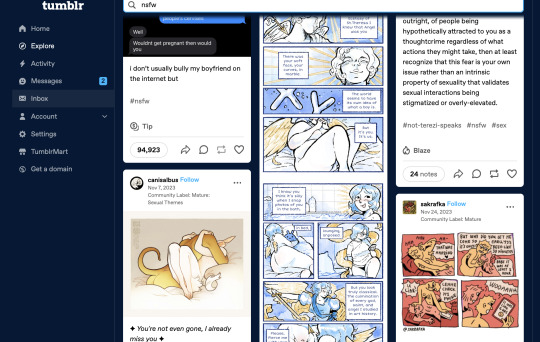
The shadow of openness:
Because of Tumblr's excessive "openness," it has led to some negative aspects. Like June said, Tumblr is a mishmash of thematic blogs revolving around every topic imaginable (2014). The feature of anonymity coupled with Tumblr's limited moderation has led to the emergence of inappropriate content, making some people feel violated and unsafe when using this platform. Moreover, there is a risk to security and privacy when users may lose control over their personal information when shared widely. The loose content control policies on Tumblr can lead to the spread of misinformation, rumors, and even fake news. This lack of control can affect the platform's credibility and create an unsafe environment for users.
#NSFW
In 2018, Tumblr issued a complete ban on Not Safe For Work (NSFW) content to restrict the posting of inappropriate images and animations. However, this transition process faced many challenges and criticisms. The lack of robust datasets due to Tumblr's previous lenient stance on adult content contributed to erroneous automated decisions and lack of transparency, leading to the removal of diverse content due to mistakes. Transforming Tumblr into a safer space is associated with sacrificing group cultural activities, raising concerns about losing the positivity of the "old Tumblr" and disrupting the community. Automatic filters hiding NSFW content sparked intense reactions due to misclassification and unaffected adult entertainment programs. The shift from user-controlled self-assessment to machine learning algorithms was criticized for gender bias and functional disorders. Algorithm errors, such as flagging LGBTQ+ content as adult content, disappointed users, mocking the system's inefficiency. Tumblr's poorly trained algorithm increased concerns about Verizon's indifference, fueling online resistance with criticisms focused on "nipple" as a symbol of rebellion.
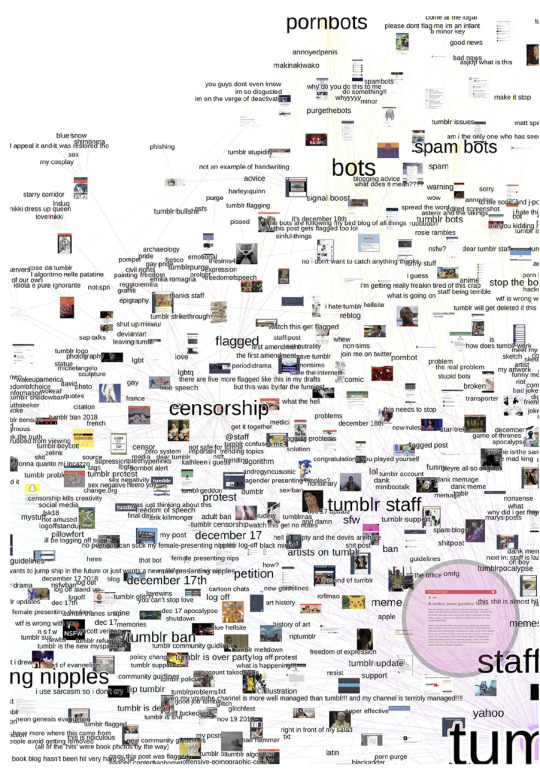
The question remains: where is the line between openness and responsibility?
Reference lists:
Reeve, E. 2016 'The Secret Lives of Tumblr Teens'
Jacomy M, Venturini T, Heymann S, et al. (2014) ForceAtlas2, a continuous graph layout algorithm for handy network visualization designed for the Gephi software. PLoS One 9(6): 1–12.
Power, JL 2014, “Tumblr,” Journal of access services, vol. 11, no. 2, Taylor & Francis Group, pp. 91–96.Pilipets, E., & Paasonen, S. (2022). 'Nipples, memes, and algorithmic failure: NSFW critique of Tumblr censorship'.
2 notes
·
View notes
Text
Just learned that I share the same birthday as one of my greatest heroes, film director and screw-you-censorship extraordinaire Ken Russell.
I think it first clicked with me that Ken was truly my kind of guy was not having my mind blown by Altered States as a kid, nor was it being so bewildered by Tommy on first watch that I had no idea if it was even a "good" movie or not ("good" feels to unanimous and general, while Tommy is in essence a film of extremities and therefore so polarizing as to seemingly transcend such simple categorical labels) yet was so entranced that I had to watch it over and over. (I have since come to the conclusion that it is one of the best things ever made, if not the best thing ever made, because DUH that's what it is.)
No, it was deciding to give Lisztomania a watch because A) I wanted a reasonable and restrained excuse to look at Roger Daltrey's face and B) I could not believe that they literally taglined it "It out-Tommys Tommy". Upon seeing that oh so ubiquitous sentence the inner skeptic in me immediately shook its head and went "nah, that's not real" (and was positively shocked and interested in the use of "Tommy" as a verb, presumably meaning "to be super weird and trippy and therefore awesome").
Lisztomania was so disorienting at first watch that I watched it again a few days later after catching up on my Liszt via Wikipedia (it's actually a pretty faithful adaptation of his life, albeit a little jump-around-y, and of course stuffed with the required exaggerations, metaphors, and anachronisms). I don't think it "out-Tommys Tommy" but that's just because every Russell film I've seen is totally in its own league and it's hard to compare them.
But the thing that really got me is that I'm the kind of person who prefers to go into movies, books, and the like with as little knowledge of the actual content as possible. I like being shocked and surprised by the media I consume. So color me extremely red in the face when, in a most beauteous sequence, Roger Daltrey's character hallucinates that he gets a ten foot erection - it just kind of happens and I was not expecting it at all; I was highly disturbed, in the best way possible.
Now that the initial shock has worn off I see that it is a very funny scene (which totally only Roger could've pulled off, and those facial expressions, yeow!) But the more I think about it, the more I'm thinking, "That was all Ken Russell, the Santa Claus of pushing boundaries, thinking that up. And he convinced big-budget movie people to give him the money to make that movie (Lisztomania was a BIG budget movie and was heavily promoted, even though everyone in today's awful world forgets that it exists because they just can't handle a giant dong kickline, let alone intelligent blasphemy, rampant trippiness, "Gay News", etc etc etc). And he convinced Roger Daltrey to do that, and it was awesome.
"Damn you, Ken Russell, you weird pervert with your powers of persuasion you, you are too fucking cool."
And that's why I'm proud to share my birthday with the man, the myth, the legend, Ken Russell. Whuppeeee.

(Here's a Lisztomaniacal Daltrey playing me the harp to help Russell enlighten my sicked-out brain cells, killing me instantly.)
#Ken Russell#Lisztomania#Tommy#The Who Tommy#cult movies#Roger Daltrey#classic scenes of cinema history
4 notes
·
View notes
Text








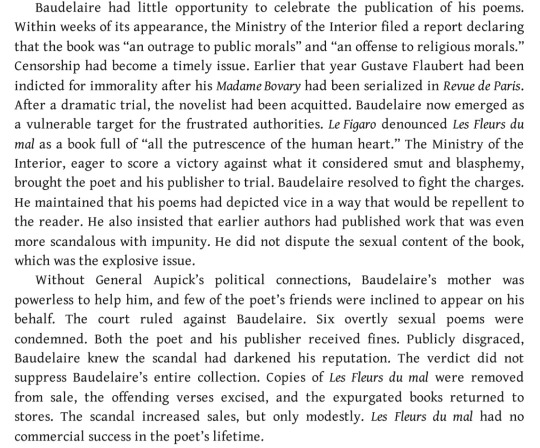
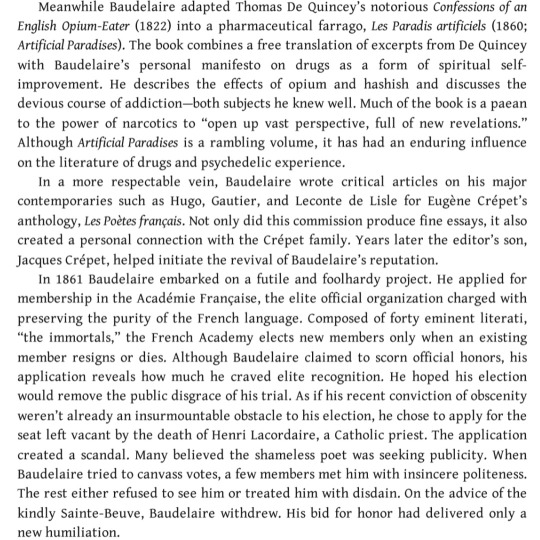
Only in 1949 did French censorship laws change so that a truly complete version of Les Fleurs du mal could be published - ninety-two years after the obscenity trial. The final version contains 158 poems. Six poems that couldn't be published for legal reasons at the time were: Les Bijoux (The Jewels), Le Lethe, A Celle Qui Est Trop Gale (To One who is too Cheerful), Lesbos, Femme damnees: Delphine et Hippolyte (The Damned Women: Delphine and Hippolyte), and Les Metamorphoses du vampire (The Metamorphoses of the Vampire).
The title of Les Fleurs du Mal is evocative, contradictory, and allusive. The title subverts the classical view that identifies the beautiful with the good; it asserts there is beauty in sickness. It creates an image that is both beautiful and dangerous, pleasurable and corrupting (in French the title phrase also carries the meaning "the flowers of sickness.") The title is also sexually suggestive; the flower is the traditional poetic image for budding sexuality (the destructive lure and consequences of sexual desire). Using the term fleurs to refer to his verse, Baudelaire alludes to the Greek root of anthology, "a gathering of flowers." The poet, therefore, positions this collection as part of the classical tradition while also subverting it with "du mal." Unlike traditional collection of lyric verse, Les Fleurs du mal is not a gathering of beautiful poetic flowers, but a bouquet of evil blossoms.
A distinguishing feature of Baudelaire's poetry is the rich texture of his lines. French style, in both prose and verse, has historically been characterized as clair, simple et logique (clear, simple and logical). These qualities were especially evident in French poetry of the eighteenth and early nineteenth centuries. Poets crafted lines of elegance, balance and lucidity. By contrast, Baudelaire's lines are more densely packed. He shows less concern with clarity and ease of his lines than with how much meaning he can concentrate into musical shape. For example:
A massive chest of drawers crammed with lines of verse,
court summonses, love letters, novels, balance sheets
and locks of ample hair rolled up in old receipts
hides fewer secrets than my melancholy brain
"Spleen et Ideal," which opens Les Fleurs du Mal, is the longest and most diverse of the volume's five sections. It requires explanation since the word in English no longer carries the meaning it did for Baudelaire. No term is more important in understanding Les Fleurs du Mal, which may accurately be described as a poetic exploration of spleen. In French, spleen is an anglicism, but the original root is Greek. Greco-Roman doctors believed that the black bile secreted by the spleen produced melancholy, one of the four humors or temperaments of classical medicine. In French, spleen came to mean a depression or melancholy characterized by guilt, ennui, isolation and despair. In English, the term also suggested outbursts of splenetic anger. Spleen is the dominant mood of the Baudelairean persona in Les Fleurs du mal throughout the book. He sought to express the sources of his anger and melancholy. This dark temperament has become so closely associated with Les Fleurs du mal that in French the term is often called spleen baudelairien.
A dozen poems form a cycle that explore sexual desire and its consequences. In "La Destruction," the demon of lust brings the speaker to ruin and damnation. Sexual desire has left the narrator wounded in filthy rags. Who writes such a poem? A young man who knows that he will die from syphilis. "L'Amour et le Crane (Love and the Skull)" describes a macabre engraving of Cupid sitting on a skull blowing bubbles. "La Metamorphoses du vampire" presents a lubricious seductress who, once the sexual act is consummated, is revealed to be a rotted skeleton. The act itself is transcendent, but the downfall is repugnant.
His forceful prose style conveys the originality and perspicacity of his insights. "Always be a poet," he wrote, "even in prose." He describes the perpetual tension between two antithetical forces, and how, trapped in ennui and ego, we long for transcendent meaning. His prose represented a genuine religious and existential rebellion against a seemingly indifferent God. Seeing himself as irrevocably flawed, he chose to embrace his own damnation. "Revolte," unavoidably brings up Baudelaire's strange and inverted Catholicism. It is impossible to understand him as a secular poet. He remained inside the Catholic worldview even as he violently tried to escape it. "Nothing upon this earth is interesting," he wrote, "except religion." He proposes a Catholicisim without Christ - a faith, therefore, that lacks the power to redeem humanity from original sin. Marcel Proust astutely described Les Fleurs du mal as "that sublime but sardonic book in which piety sneers, in which debauchery makes the sign of the cross; in which Satan is entrusted with the task of teaching the most profound theology." In Le Reniement de saint Pierre (Saint Peter's Denial), he presents the Crucifixtion with respectful compassion, but then congratulates Peter for denying Christ. In Abel et Cain, Baudelaire praises Cain for killing his own brother to protest God's plan. Post-revolutionary France was inured to sacrilege and anti-religious satire, but Baudelaire pushed that tolerance to the limits.
In the spirit of Balzac, he presented a realistic street-view of Paris - the disenfranchised, poor and elderly, the workers, beggars, and prostitutes, "the thousands of stray souls - criminals and kept women - who drift about in the underground of a great city."
Before Baudelaire, poets had presents the darker aspects of things in their poems, but had never connected to the beautiful or the sublime. Baudelaire's poetics of evil, however, possess its own ambiguity. Is the discovery of evil transgression or redemptive? Is its aestheticization an end in itself, or must it be connected to a broader frame of values? Does Baudelaire's aesthetic revolution destroy traditional notions of beauty, or does it only broaden the aperture of beauty to reconcile all that exists to an ideal order?
2 notes
·
View notes
Text
I thank Jah for the ‘workin class’ women that raised/saved me. I thank jah for the women whose labor did not have to extend to the love we shared. Chai, I thank Jah for the young women of the east dat allowed me peeks into intimacies dat declared a sort of wayward freedom. I thank jah that they owed me no censorship in the embrace of their womanhood and hence, waywardness, dat they allowed to be freeeee within their most inner spaces. Chidinma, Lilian, Sefi, Funto, Naomi, Peace, Blessing, Ebele, Gloria, Nneka, Anita. My first sisters, my first friends. I’m following your steps as I find myself at a point in my womanhood where the world demands me of my labor, I thank Jah that from birth you all blurred the conditions of labor. That we could dance, cry and laugh in spaces that demanded otherwise. That we could talk about sex and pleasure in spaces unable to recognise the body past its commodification. That I could watch you be. I thank Jah that I was never just apart of the ‘job’, dat the deep love we shared somehow always transcended 2 become the otherwise of a union enforced thru labor.
13 notes
·
View notes